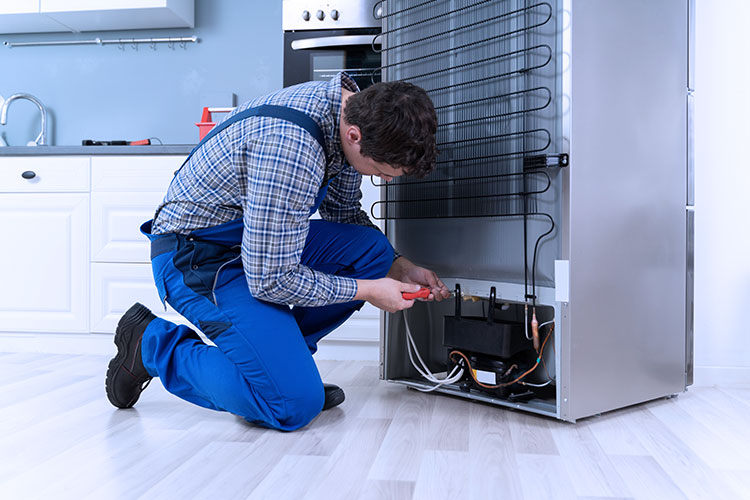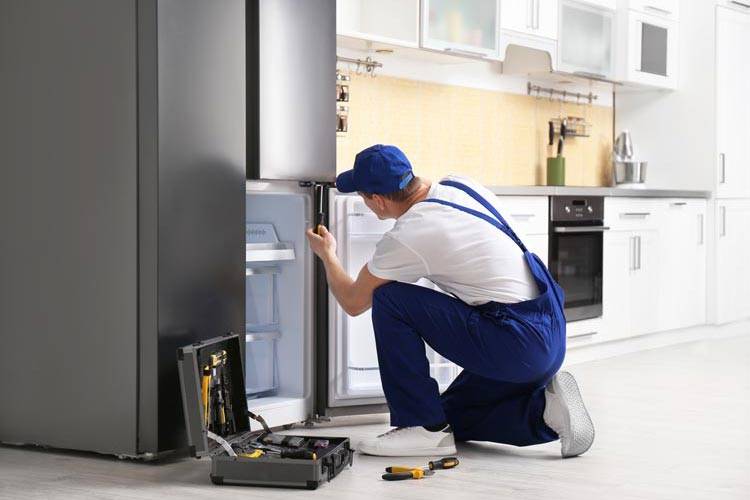Don’t Wait—Fix it Now! with Dependable Refrigeration & Appliance Repair Service Sub-Zero Appliance Repair
Don’t Wait—Fix it Now! with Dependable Refrigeration & Appliance Repair Service Sub-Zero Appliance Repair
Blog Article
The Ultimate Overview to DIY Home Appliance Repair Service Techniques
From fridges to dishwashing machines, recognizing exactly how to repair and fix these devices can save you time and money. Are you ready to discover essential methods that will equip you to manage fixings with confidence?
Recognizing Usual Home Appliance Troubles
When you depend on your home appliances, it can be annoying when they instantly quit working or act up. Recognizing usual device issues can assist you fix issues effectively. If your fridge isn't cooling down, inspect the temperature level settings or inspect the door seal for gaps. A malfunctioning washing machine could be as a result of a blocked drain filter or a busted belt.
If your oven isn't home heating, defective components or thermostat problems could be to blame,. Dish washers typically experience problems with water drainage, so make sure the filter is tidy and the drainpipe pipe isn't kinked.
Likewise, listen for unusual sounds; they commonly suggest mechanical problems. By acknowledging these signs, you can save time and potentially prevent costly repair services. A little knowledge goes a lengthy method in keeping your home appliances, so stay notified to keep every little thing running smoothly.
Crucial Tools for Do It Yourself Services
Before diving right into DIY home appliance repair work, it is very important to collect the right tools to assure the procedure goes smoothly. Begin with a great collection of screwdrivers, consisting of both flathead and Phillips, as they're essential for opening up most devices. You'll also desire a set of pliers for gripping and twisting cords or small elements.
Don't neglect a multimeter; it aids you test electric elements and detect issues properly. An outlet set is convenient for loosening or tightening screws, while an energy blade can be valuable for cutting cords or opening up packaging.
Lastly, consider having a flashlight on hand to illuminate dark rooms inside your appliances. With these important tools, you'll be well-appointed to tackle numerous repair work, saving both money and time. So, collect your gear and obtain all set to roll up your sleeves!
Safety First: Precautions to Take
Prior to you begin any kind of appliance repair service, it's necessary to prioritize safety and security. Make sure you wear personal protective devices, disconnect the power source, and keep your work area arranged. These straightforward preventative measures can help protect against crashes and assure a smoother repair work procedure.

Personal Protective Tools
Safety and security equipment is a necessary part of any kind of do it yourself appliance repair service project. You should always put on safety and security goggles to protect your eyes from dirt and debris. A tough set of handwear covers will secure your hands from sharp sides and unsafe products. Consider making use of a mask if you're handling chemicals or dust, ensuring you take a breath securely while working. Steel-toed boots are additionally a smart selection, specifically when raising hefty home appliances. Do not forget to put on lengthy sleeves and pants to safeguard your skin from prospective injuries. By prioritizing personal safety tools, you'll considerably lower the danger of injuries and mishaps. Remember, being prepared with the right equipment maintains you secure and concentrated on completing your repair work efficiently.
Source Of Power Disconnection
To guarantee a secure DIY device repair, detaching the power resource is essential. Prior to you begin any kind of job, you ought to unplug the appliance or turn off the breaker. This simple step stops electric shocks and guarantees that you can focus on the repair service without stressing regarding accidental activation. Always double-check that the home appliance is off by checking it with a voltage tester. If you're taking care of larger home appliances, like a washing machine or dryer, make certain to protect the power cable and prevent any kind of call with water. Remember, safety! As soon as you're positive that the power is detached, you can confidently wage your repairs, understanding you have actually taken the required precautions to protect yourself.
Workspace Company
A well-organized work area can make all the difference in your Do it yourself device fixing task. Start by clearing your work area of clutter to protect against crashes and diversions. A tidy room not only increases effectiveness yet likewise maintains you safe while you function on your appliance repair.
Step-by-Step Guide for Refrigerator Fixes
When your refrigerator begins breaking down, it can be frustrating, but taking on the issue yourself can conserve you time and money. First, disconnect the fridge to assure safety and security. Examine for typical problems like temperature level variations or uncommon noises. Evaluate the thermostat settings; they might be set as well high if it's not cooling down. Next off, clean the condenser coils, which often collect dirt and particles. For a noisy refrigerator, inspect the follower and confirm it's not blocked.
If there's water merging within, inspect the door seals for damages or dust, and clean them if essential. Once you've addressed the concern, plug the fridge back in and monitor it for a few hours.
Fixing Cleaning Equipment Problems
Similar to refrigerators, cleaning machines can provide their own collection of challenges, however many concerns can be resolved with a little bit of troubleshooting. First, if your machine won't begin, examine the power cable and validate it's plugged in. Next, evaluate the door latch; a faulty latch can prevent the cycle from beginning. It may be due to international things stuck in the drum or the drainpipe pump. if you discover uncommon noises during procedure.
If your clothes aren't getting clean, consider the water level and detergent kind; utilizing excessive detergent can produce excess suds, affecting performance. For leaks, analyze the tubes for cracks or loosened connections. Tightening these can typically resolve the issue. Normal maintenance, like cleaning up the filter, can protect against several issues from developing. Remember, a little troubleshooting goes a long method in keeping your washing machine running smoothly.
Repairing Stoves and stoves
How can you troubleshoot usual concerns with your oven or range? Begin by inspecting the power supply.
If your oven isn't heating, examine the temperature settings and validate the door seals tightly. If it's harmed., a damaged heating element can likewise be the perpetrator; you might need to change it.
For irregular food preparation, turn your frying pans and think about utilizing a stove thermometer to confirm precise temperature levels. If you hear uncommon noises or odor gas, transform off the home appliance immediately and speak with an expert. By adhering to these steps, you can determine and fix lots of typical stove and cooktop problems successfully.
Fixing Dishwashers Made Easy
When your dishwasher begins breaking down, it can be aggravating, however attending to typical concerns isn't as difficult as it appears. You'll learn detailed troubleshooting approaches that will certainly aid you determine the trouble, in addition to the crucial tools you'll need to deal with fixings on your own. Let's make fixing your dish washer a breeze!
Common Dishwashing Machine Issues
While dishwashing machines are made to make your life less complicated, they can in some cases face common concerns that leave you really feeling annoyed. One regular trouble is inadequate cleansing efficiency; this typically occurs because of clogged up spray arms or filthy filters. You may additionally notice water pooling at the base, which can suggest a kinked pipe or a defective drainpipe. It can be a straightforward concern with the lock mechanism or door seal if your dish washer's door won't latch. In addition, weird noises can signal damaged elements or loosened components. Finally, if you scent something odd, it may be time to look for food particles or a malfunctioning electric motor. Attending to these concerns early can conserve you time and hassle down the roadway (Emergency Sub-Zero Repair Dependable Refrigeration & Appliance Repair Service).

Detailed Troubleshooting
Prior to diving into repair work, it's vital to recognize the certain concern your dishwashing machine is encountering. If it's not you can try this out cleaning up effectively, Begin by inspecting. Examine the spray arms for blockages and guarantee they spin openly. Check out door seals and hoses for any type of damages if it's leaking. For odd noises, listen closely during cycles; foreign objects could be embeded the filter or impeller. Check the power supply and door latch if your dishwashing machine won't begin. Don't fail to remember to consult your customer click to read manual for troubleshooting suggestions details to your model. By carefully attending to each prospective issue, you can pinpoint the trouble and take the needed steps to repair it, making your dish washer feature fresh once more.
Essential Fixing Tools
Having the right devices available can make all the difference when fixing your dishwasher. Begin with a screwdriver collection, as you'll often need both Phillips and flathead options. A multimeter's important for detecting electrical problems, while pliers can aid you grip and manipulate various components. Don't forget a container or towels for any kind of water spills throughout fixings.
You might likewise desire a level to ensure your dish washer's correctly straightened. With these crucial tools, you'll be well-appointed to take on any dishwashing machine repair obstacle that comes your way.
Frequently Asked Concerns
If an Appliance Is Worth Fixing?, just how Do I Figure out.
To determine if an appliance's worth repairing, consider its age, repair service prices, and current value. If repair services go beyond half the substitute price, you might intend to buy a brand-new version rather.
Can I Find Replacement Components In Your Area for My Home Appliance?
Yes, you can commonly locate substitute components locally for your appliance. Examine equipment stores, appliance service center, or neighborhood classifieds. Do not neglect to bring the design number to guarantee you get the proper component!
What Typical Mistakes Should I Avoid When Fixing Home Appliances?
When repairing appliances, avoid hurrying through diagnostics, overlooking safety and security precautions, or using wrong tools. Do not avoid reading guidebooks or enjoying tutorials; they offer important guidance. Hold your horses and extensive to guarantee effective repair work and protect against additional damage.
Exactly how Long Does a Normal DIY Home Appliance Repair Take?
A regular DIY device repair work generally takes one to three hours, relying on the complexity. You'll desire to gather your materials and devices first, and comply with instructions very carefully to avoid unnecessary hold-ups.
Are There Any Service Warranties for Do It Yourself Device Repair Works?
When you take on DIY home appliance repairs, guarantees typically don't cover your job. Some manufacturers might honor service warranties for parts you change. Always check your home appliance's service warranty terms prior to beginning any repair work to prevent concerns.
Before diving into DIY home appliance fixings, it's important to gather the right additional info tools to ensure the procedure goes efficiently.Prior to you start any kind of appliance repair service, it's essential to prioritize security.To ensure a risk-free Do it yourself device fixing, separating the power resource is essential.A well-organized work location can make all the distinction in your Do it yourself device fixing task. Constantly inspect your home appliance's guarantee terms before starting any repairs to avoid issues.
Report this page